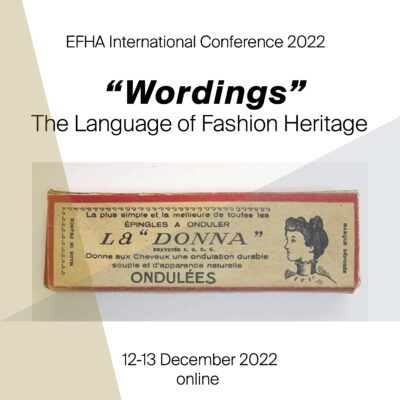
EFHA World 03.11.2022
15.12.2022
efha2022fashion conferencefashion heritagewordings
Two days of compelling presentations and exciting discussions to grasp the political value of the language of fashion heritage
Is fashion heritage political? And what about its language? They are – both of them, and the EFHA 2022 Symposium ‘Wordings?’, which took place at the beginning of this week, surely proved how important it is to reflect on words when it comes to describing, interpreting, cataloguing objects.
The symposium stemmed out of several conversations that have become more and more pressing for museums and cultural institutions in general: address biases intrinsic to old cataloguing and other museological practices; rethink objects’ institutional definitions and propose new vocabularies to the public; engage with communities and scholars to update biased methods of acquisition and set new standards in cataloguing practices. Since the reconsideration of terminology is leading to a more thorough understanding of objects and their cultural value, we decided to ask our speakers to present different perspective on how words have been used, are used, and hopefully will be used, to propose a varied scenario that, from past to present, can instruct some ways to think about the future of fashion heritage.
The first panel, Establishing Vocabularies, defining identities, focussed on terminologies and projects related to the development of glossaries and thesauri allowing us to access more easily to shared fashion heritage. Between the presentation of past endeavours and the introduction of future projects, the panel ultimately reflected on what goes lost in translation when dealing with objects, artefact and documents that are so linked to national differences and political and commercial agendas, as shown by Matteo Augello and Paula Alaszkiewicz. Linguists and fashion historians helped us defining the identities connected to the linguistic articulation of heritage.
The second panel, Rethinking Collections, representing communities, looked more closely at experiences and case studies that used words in an inclusive and creative way, either forming an entirely new language (where the one needed was simply not there yet!) as in the presentations by Daan Van Dartel and Elisabeth Murray, or questioning the historical resonance of linguistic stereotypes, as demonstrated by Roberto Luis Martins. It also ventured in themes as body diversity, oral testimonies and intangible heritage, even more strongly paving the way for the update of established and trusted vocabularies.
Once again, during both Q&A sessions, the participants provided even more insights on their own work and approach towards descriptions and definitions, central to communicating through objects, and also telling their true, nuanced story.
The recordings of the conference are now available on our Vimeo channel – to check them out, follow these links: Day 1 and Day 2